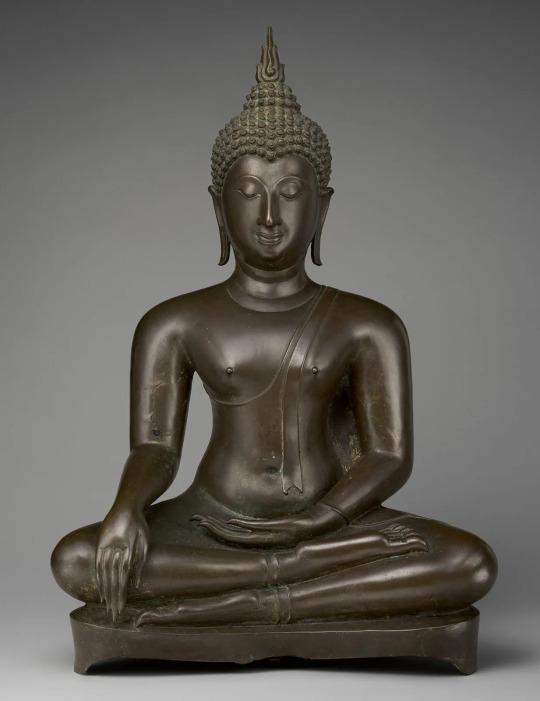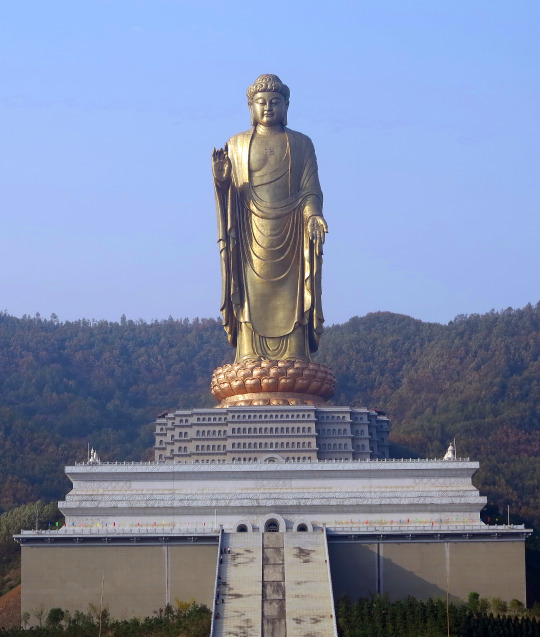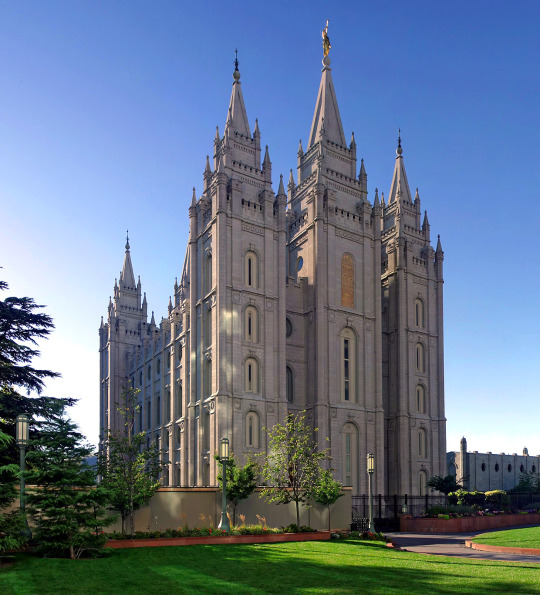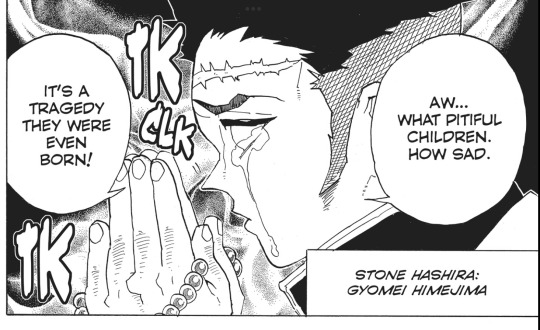#Pure Land Buddhism
Explore tagged Tumblr posts
Text
The diversity of Buddhism is fascinating. All the way from “there are no gods, there are no miracles, there’s no such thing as an immortal soul, karma and reincarnation are just metaphors,”

to “Siddhartha Gautama the Buddha was one human incarnation of the omnipotent multiversal being Mahāvairocana who came to give supernatural powers to his Enlightened followers, one of whom, Amitābha, made a Pure Land where you can go after you die if you call upon his name.”

Granted you could also kind of say the same thing about Christianity, but that’s always been a lot more self-policing of deviance, after all if you think there’s only one truth you want to nail down what exactly it is. Groups like Gnostics or Unitarian Universalists have always been marginalized, with the possible exception of the Mormons, who were isolated enough to actually build up some population.

#religion#atheism#buddhism#theravada#mahayana#tibetan buddhism#zen buddhism#pure land buddhism#latter day saints
30 notes
·
View notes
Text
Pure Land Buddhism
Key Features of the Pure Land:
Amitabha Buddha: The most well-known Pure Land is Sukhavati, the Western Pure Land, created by Amitabha Buddha. Amitabha made vows to establish this realm to help beings achieve enlightenment.
Rebirth in the Pure Land: Devotees aspire to be reborn in the Pure Land by chanting Amitabha’s name with faith and sincerity. This practice is known as Nianfo in Chinese or Nembutsu in Japanese.
Characteristics: The Pure Land is described as a place free from suffering, where the conditions are ideal for practicing the Dharma. It is filled with beautiful landscapes, precious materials, and constant teachings of the Buddha.
Accessibility: Pure Land Buddhism is known for its accessibility. It offers a path to enlightenment that does not require complex meditation or rigorous ascetic practices, making it appealing to a wide range of practitioners.
Pure Land Buddhism emphasizes faith, devotion, and the compassionate vows of Amitabha Buddha, providing a hopeful and supportive path for those seeking enlightenment.
7 notes
·
View notes
Text
18 notes
·
View notes
Text



Pure Land Amitabha Buddha
Artwork for temple in Taiwan by Voyager on (aka Christian Benavides) Bēhance



#christian benavides#voyager illustration#amitabha#buddha#pure land buddhism#buddhist art#digital art#digital illustration
15 notes
·
View notes
Photo

A painted image of Amida Buddha (阿弥陀如来) and his entourage of bodhisattvas swooping in quickly to escort the faithful to his Pure Land in the west
Color on silk dating to the 13th century from the collection of Chion’in Temple (知恩院) in Kyoto
#japanese art#buddhist art#阿弥陀如来#阿弥陀#amida nyorai#amida#京都#kyoto#知恩院#chionin#浄土宗#jodo#pure land buddhism
54 notes
·
View notes
Text
Resources for Beginning Buddhists
I compiled this list to help prospective converts and Buddhi-curious folks in learning more about Buddhism generally and the Chinese Pure Land tradition specifically ahead of Master Renshan's 3 Refuges and 5 Precepts ceremony on 03/28/24.
I was going to post it alongside a link to the registration page for the event but I thought it'd be nice to put it on a post all its own. In the future I'm also hoping to update with more resources from other schools.
Pure Land Buddhism YouTube channel by Master Renshan's student Jiawen:
What Exactly Did The Buddha Teach ☸️
4 Noble Truths (1): 8 Types of Suffering
4 Noble Truths (2): Craving is the Cause of Suffering
4 Noble Truths (3) & Noble Eightfold Path
What are the Three Refuges?
What are the Five Precepts?
Why do Buddhists Bow and How?
Why to Have a Dharma Name? #dharma
What is Pure Land Buddhism?
Why Pure Land is Not Another Heaven
5 Pure Land Sutras & 1 Treatise
Playlist of English-subbed clips from Master Renshan's Dharma talks available on his YouTube channel
Why is Nianfo the easiest and most effective practice?
How to cultivate the habit of Nianfo
How people have misunderstood Pure Land Buddhism
There are no requirements to study Buddhism and everybody can learn
Learning Buddhism is to live a happy life
Pure Land Buddhism resources from Jiawen's Website
Pure Land Sutras
Other Sutras
Books
Biographies of Pure Land Patriarchs
Animated Sutras produced by Aputi (Chinese with English Subs)
Amitabha Sutra
Visualization Sutra
Infinite Life Sutra
Practices and Vows of Bodhisattva Samantabhadra
Bodhisattva Mahastamaprapta's Realization of Nianfo Samadhi
19 notes
·
View notes
Text
i really would like to learn to appreciate pure land buddhism but the whole concept of pure lands seems to contradict the teachings of the buddha in the tipitika and i can’t seem to reconcile those concepts at all. it just seems unnecessary to me
3 notes
·
View notes
Text

A quote from Honen Shonin.
2 notes
·
View notes
Video
youtube
The Origin of Humans on Earth
May all beings hear the name of Amitabha Buddha and be reborn in His Land of Ultimate Bliss 🪷🙏
🙏 Namo Amitabha Buddha 🙏
🙏 Namo Amituofo 🙏
2 notes
·
View notes
Text
Into the Pure Land 🪷

Buddhism was introduced during the 6th century in Japan. It was an Indian religion based on the teaching of Siddhartha Gautama. The teachings soon spread into other parts on the land, and particularly in China had a great adherence that resulted in an evolution in the research and practiced of the religion. “The study of buddhism over the past century or so has resemble the encounter of the blind men and the elephant in many ways. Students of Buddhism have tended to fasten onto a small part of the tradition and assume their conclusions held true about the whole”- Keown, 2000 When the Japanese looked at the continent, they saw a civilisation that had a centralised government, and they wanted the same, but for that the introduction of a new religion was needed since politics was still extremely related with the government. But they had a problem: the power basis in which the imperial family laid was based in a religion itself, and so introducing a new religion could be dangerous to their power. Taking things with a grain of salt, the imperial household would allow religious liberty so that Buddhism would naturally spread in the territory and even more naturally they could use the Buddhist rules without destroying the whole narrative that they had built where the imperial family were the living descendants of Amaterasu. But conflicts would arise (like they always do when religion is the topic let’s be honest) between the Shintoism forces and Buddhist forces. While the Shintoism forces gain momentarily, the Buddhist will counterattack and in 587 the Chinese administrative model is implemented. The learning of the Chinese ways was not with in intent of transform Japan into a new China, but to utilize this new knowledge knowing what would make the country better - it’s the filtering of knowledge [and as we now know this will happen a lot throughout the history of Japan]. It's also the time where the name of the country changes from Yamato to Nihon - the country of the rising sun.

When we talk about Japanese Buddhism one figure comes to mind: Prince Shotoko, a figure that studied the Buddhism, Korean culture, and Confucianism [a reminder that most of the times, Chinese culture arrived in Japan through Korea] Prince Shotoko would end being the one in charge of the introduction of buddhism, meaning the introduction of religious sects or the law and court changes, and, thanks to that he would end up becoming venerable person himself. But Buddhism would soon turn out to start to have a social function. Noble families would start to build temples, and to alleviate family tensions while the heir would go on to inherit the household, the 2nd son, most of the times, would be send to temples (sounds familiar? Yes that was what happen to the Tsugikuni twins). And soon the ones that led the temples would also lead the political power. Buddhism would soon turn out to be a means to and end and the political power would be the wanted end. An as we talked about in the timeline, the Heian period would cut ties with the religious sects, and more simple Buddhists ways that were open to all became predominant. In beginning the Pure Land Buddhism was not seem as a religious cult, more like an association with the ancestor’s cult that are so important to the Japanese as we have seen in the ideas of afterlife. "Although Buddhist scholastic discourse held that the Pure Land was a realm existing beyond the world of transmigration, at this early stage was simply understood as a pleasant abode of the dead." - Rhodes, 2006 The Pure Land Buddhism would preach that by being mindful of Amida Buddha the chance of rebirth on the pure land would increase. There was 2 important texts Ojoyoshu written by Genshin (again, the monk not the game) and Gokuraku-ki written by Yoshishige no Yasutane. Genshin like many in his time thought that the age of the Last Dharma was arriving [for context the Buddhist timeline said that after Buddha's nirvana the times would be divided in 3 times: the true dharma - the golden age of Buddhism teachings - semblance dharma - the world would increasingly become corrupt - and the latter dharma - the world's condition was so poor that only buddha's teachings would remained but no enlightenment would be possible], he would argue that since the world was deteriorating it was extremely difficult to gain liberation from the cycle of transmigration by practicing the traditional Tendai way, so one could seek salvation into Amida Buddha's Pure Land. Genshin goes on to say that the Six paths of rebirth [Hell, starving ghosts, beasts, Ashuras [Titans], Humans, and Heavenly beings] are always a troubled way the only way one could seek peace is attaining rebirth in the Pure Land. And how could one obtain the rebirth into the Pure Land? By practicing the Nembutsu. He describes the Nembutsu as a practise of visualizing the figure of Amida Buddha. This would be divided into the Mental Nembutsu and Vocal Nembutsu. Mental Nembutsu would refer to meditation and the visualization of Buddha. Those incapable of visualizing his marks can try his tuft of hair between the eyebrows. (yes the dot) But for those that cannot visualize anything it was recommended the Vocal Nembutsu that would refer to the practice of recitation of the formula "Namu Amida Butsu" (Yes the sentence that the rock hashira Gyomei Himejima choose to say to focus, which again, makes sense since he was a Buddhist priest) where gradually one would focus one mind on Amidah and eventually embark on the practice of the meditative nembutsu. "Both types of nembutsu, meditative and vocal, result in three kinds of benefits: (1) the eradication of evil karma created over the course of countless past lifetimes which keeps one bound to the cycle of transmigration, (2) the attainment of good karmic roots leading to awakening, and (3) the ability to remain mindful of Amida Buddha at the moment of death (..)" - Rhodes, 2006

According to one of the main texts even a person that had committed the Five Heinous Crimes [01 - Killing one's mother; 02- Killing one's father; 03 - Killing a saint; 04 - to wound the body of a Buddha; 05 - to destroy the harmony of the sangha] could be born in the Pure Land by calling the Namu Amida Butsu, and this would obviously cause problems for the rules cause people would start to cause trouble. Gokuraku-ki is compilation of bibliographic narratives of various people that are believed to have obtained the rebirth in the Pure Land. Things varied but in common have the rightmost behaviour of oneself. What was trying to be said was that everyone could achieve que pure land, the things that were needed were a righteous personality, and be mindful of Amida Buddha in the end. And in Demon Slayer the influences of the teachings of the Pure Land Buddhism are quite obvious ether from the fact that Gyomei Himejima was a monk or Genya also chanting the Nembutsu, the rebirth teories (already explain in more detail in other post) or the over all philophy of doing what is right.

KEOWN, Damien, 2000 – Buddhism: a very short intrudution. Oxford. Oxford University Press. [Ebook]; Linfamy. 2022 - The Revolutionary Origins of Pure Land Buddhism in Japan | History of Japan 80. [Consulted on the 17 of June 2023] Availatble on <https://www.youtube.com/watch?v=rUG4ifeWzTk>; RHODES, Robert F. 2006 - The Biginning of Pure Land Buddhism in Japan: From its introdution through the Nara Period. Japanese Religions, Vol.31 (1): 1-22. Nanzan University; RHODES, Rober F. 2007 - Ojoyoshu, Nihon Ojo Gokuraku-ki nad the Construction of Pure Land Discourse in Heian Japan. Japanese Journal of Religious studies 34/2: 249-270. Nanzan Institute for Religions and culture;
#demon slayer#demon slayer from history to fantasy#demonslayerfromhistorytofantasy#history#demon slayer history#history research#japanese history#kimetsu no yaiba#research#buddhism#pure land buddhism#gyomei himejima
10 notes
·
View notes
Text
"The middle is the curse": Thinking from the words of Lao Tzu (Essay)

I once read the saying, "The middle is the curse." When I entered the University of Tokyo Science 1, I was overwhelmed by the classmates around me, and I was frightened by the difficulty of mathematics and physics. I came across this word when I was interested in the Pure Land Buddhism and was seeking some kind of truth. I was a little weak.
This saying, "The middle is the curse," divides human beings into three classes, upper, middle, and lower, with the highest and the lowest. Because middles think they are intermediate, they are far from the salvation of Amida Nyorai. I think it was said that it was far from salvation and that it was a bad category in terms of Pure Land Buddhism. However, I forgot the name of this book and the author, so I tried to search for this word again on Google, but I got no hits at all. I don't think it was a very popular word.
However, I came to realize that there is an expression very similar to this in my favorite book of several decades: Lao Tzu. (I did not pick up Lao Tzu out of a timidity like in the Pure Land Buddhism, but I picked up in a positive state of mind.)
There is this... When the best sage hears the "way(Tao)", he tries to do it with all his might. The man in the middle does not move, as if it were not there. The lowest class laughs at the "way". If it is not laughed at, there is no value for "the way." ・・・Outline is written like this (chapter41).
Here, rather, the lowest sage is interesting. Indeed, he has his own criteria for evaluating things, and he laughs at "the way and its practices" according to it. Depending on how you negotiate, you may understand him the "way" and put him into practice. When this happens, the person in the middle who is easily touched stands out. It can be said that he is "gray area" and is self-satisfied with his current situation. I don't know what will happen to him.
In my experience, I've come across a lot of this middle class. It can be said that they occupy the majority of the world. Humans with expressionless faces that never change, and have no intention of changing. Perhaps the commentator of the Pure Land Buddhism, or even Lao Tzu, is saying that these people "can’t be saved."
(2022.11.19)
#The middle is the curse#Lao Tzu#Pure Land Buddhism#salvation of Amida Nyorai#way#tao#chapter41#gray area#middle class#essay#rei morishita
3 notes
·
View notes
Text
Pure Land Buddhism: Origins and Beliefs
Pure Land Buddhism is one of East Asia's most widely practiced Buddhist traditions. Pure Land Buddhism is believed to be an early branch of Mahayana Buddhism. In the Pure Land tradition, most Buddha teachings are primarily based on Amitabha or Amida Buddha. Many names know Pure Land according to the country's culture and beliefs, but it is globally known as Amidism. Pure Land is the largest Buddhist school in China and East Asia. Read more at: Pure Land Buddhism - prominent Buddhist tradition in China, Japan, Korea, Taiwan, and Vietnam


1 note
·
View note
Text
Morning meditation — Among all living things mountains and rivers, grasses and trees.
Morning meditation — Among all living things mountains and rivers, grasses and trees. https://wp.me/pFy3u-8NH
‘Among all living things mountains and rivers, grasses and trees, even the sounds of blowing winds and rising waves — there is nothing that is not the nembutsu.’ Ippen Two seagulls against a blue sky. On the net, of course, it’s morning, afternoon, evening, or nighttime 😀 somewhere. Click here to read more Morning Meditation posts. On our Twitter account, Buddhism Now @Buddhism_Now, most…

View On WordPress
0 notes
Text
The Religious Landscape of Japan: From Shinto and Buddhism to Shintoization and Beyond
Japan has a rich religious history that is deeply intertwined with its cultural identity and social norms. In the past, the Japanese people believed in Shinto, a form of animism that emphasized the presence of spirits or kami in natural elements such as rocks, trees, and rivers. However, with the introduction of Buddhism in Japan from China around 500 AD, the religious landscape of Japan began to…

View On WordPress
#Amaterasu#Buddhism#Christianity#Japan#Jodo Shinshu#Kami#Meiji Restoration#Pure Land Buddhism#Shinto#Shintoization
1 note
·
View note
Text

A sculpted image of Amida Buddha (阿弥陀如来) dating to the 10th-12th century enshrined at Sainenji Temple (西念寺) in Saku, Nagano Prefecture
Photo by Butsuzolink (仏像リンク), a twitter account showcasing a fascinating range of regional Buddhist images (June 27, 2023)
#japanese art#buddhist art#阿弥陀如来#阿弥陀#amida#amitabha#長野県#nagano prefecture#佐久市#saku#西念寺#sainenji#浄土宗#jodo#pure land buddhism
52 notes
·
View notes
Text
Upcoming 3 Refuges and 5 Precepts Ceremony by Master Renshan
Amituofo, everyone!
Next March 28th at 7 PM China time Master Renshan, the abbot of Zhenning Buddhist Temple, is going to be holding a digital 3 Refuges and 5 Precepts ceremony over Zoom. To anyone wanting to formally convert to Buddhism, and especially to anyone wanting to learn from the Pure Land school, this is a great opportunity.
Master Renshan was the one who gave me my Dharma name and originally conducted my 3 Refuges and 5 Precepts ceremony and I'm going to be taking this opportunity to retake it. I hope that if I have convinced any of you to give it a shot that I'll see you there!
I have compiled a list of resources here for anyone interested in learning more.
11 notes
·
View notes